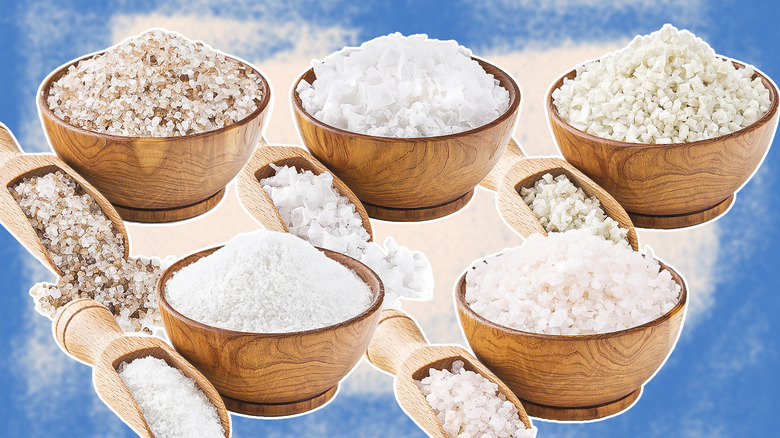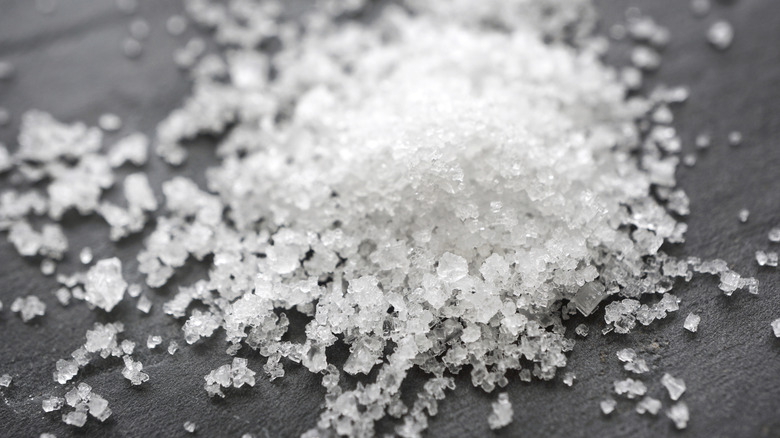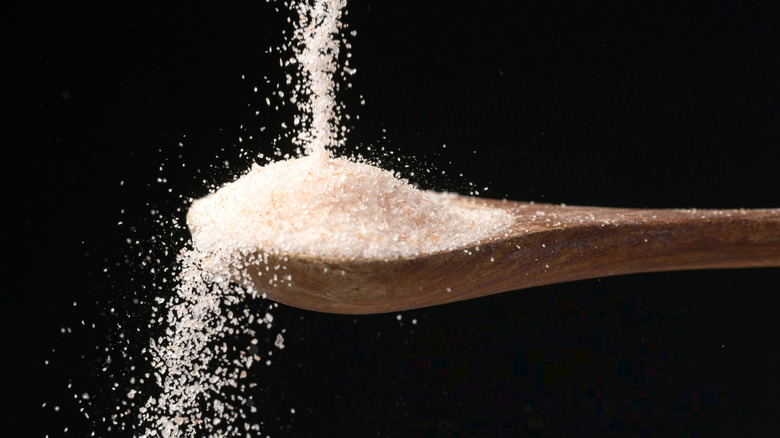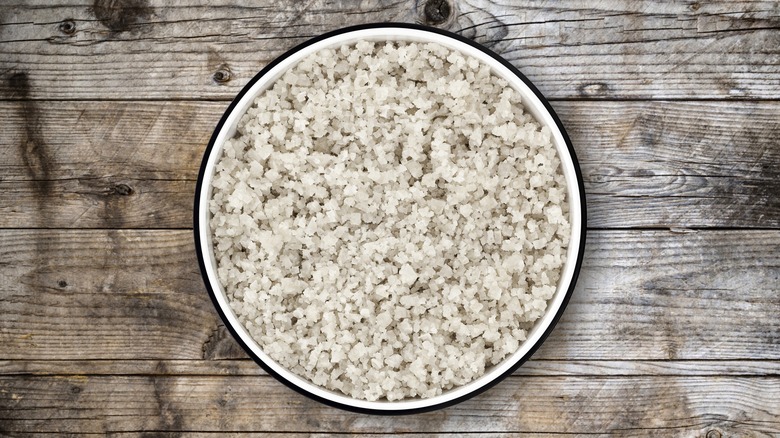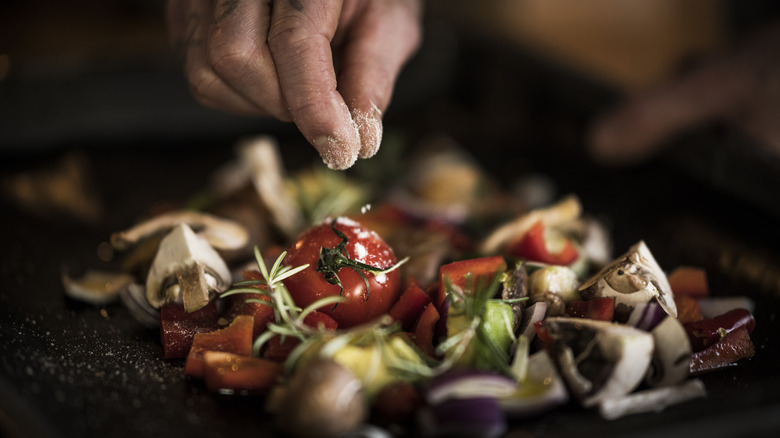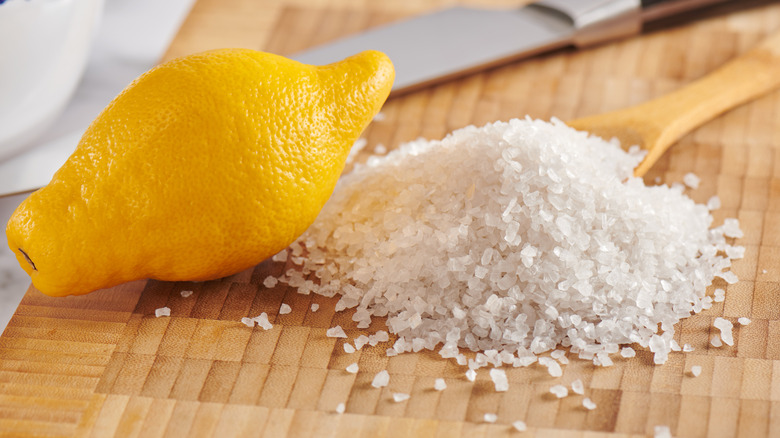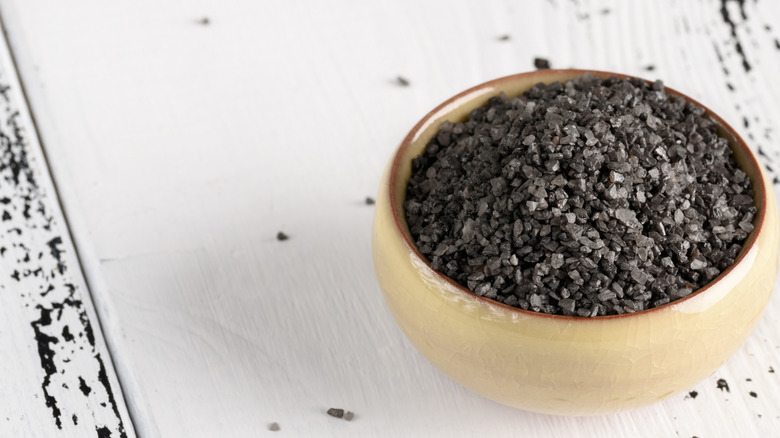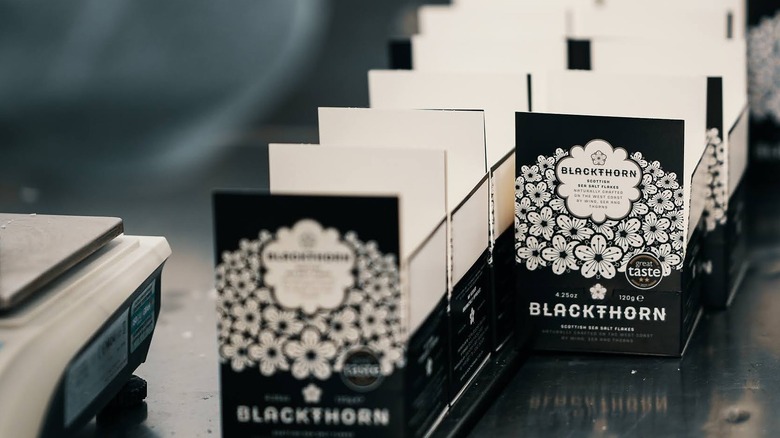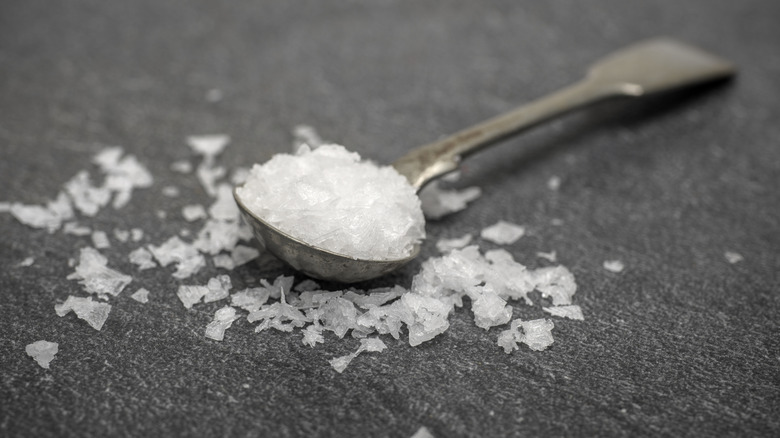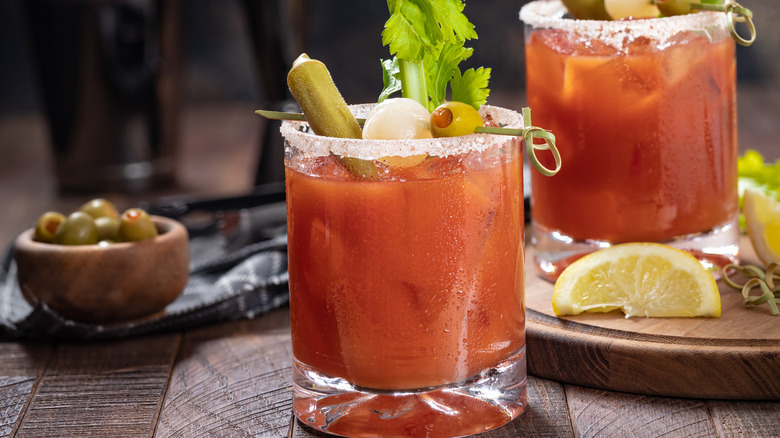10 Salts Experts Recommend Having In The Kitchen
Salt may seem like a simple ingredient, but it plays a vital role in the kitchen. Whether you're seasoning during cooking or adding the perfect finishing touch, different salts have various characteristics that impact the flavor and texture of your food. Chef Lior Lev Sercarz, author of "Mastering Spice," explains, "The difference between salts used for cooking versus those used for seasoning is more about the texture you add during and after the cooking process. The main difference is the grain and crystal of the salt."
This distinction matters because the size and shape of salt crystals affect how quickly they dissolve and how they interact with food. Finer salts, like table salt or fine sea salt, dissolve quickly as they cook, ensuring an even distribution of flavor. Coarser salts, like kosher salt, dissolve at a slower, more even pace, giving you better control over seasoning. For finishing, salts with larger crystals provide texture and a burst of flavor, sitting on the surface of the food to add a pleasant crunch and hit of saltiness.
To help you choose the best salts for your kitchen, we've consulted a few culinary experts who know a lot about salt to share their expertise on the matter. Their recommendations include all-purpose salts and specialty varieties that can enhance your meals in unexpected ways. Let's dive into their advice about 10 salts to keep on hand for seasoning and finishing your home-cooked meals.
Fleur de sel
Fleur de sel, which translates to "flower of salt," is one of the most prized salts in the culinary world. It's often referred to as the "caviar of salts" due to its delicate texture and pure, subtle flavor. Fleur de sel originates on the Atlantic coast of France, where it's hand-harvested through a centuries-old artisanal process. Fine, flaky crystals form on the surface of salt ponds and are carefully skimmed off before they sink, preserving their pristine quality. This labor-intensive method makes fleur de sel a premium finishing salt, treasured for both its flavor and craftsmanship.
What sets fleur de sel apart from other salts is its moisture and complex flavor profile. It has a mineral-rich taste with a briny, slightly sweet undertone, which adds depth to dishes beyond basic saltiness. The moist, uneven crystals of fleur de sel naturally cling together, forming small clusters that deliver bursts of intense flavor when scattered over food. This texture adds an elegant crunch that can notably enhance the eating experience.
Because of its delicate structure, fleur de sel isn't the best for cooking, as it clumps and dissolves easily under heat. Instead, it shines as a finishing salt, perfect for sprinkling over roasted vegetables, grilled meats, or even sweet treats like chocolate or caramel. Chef Lior Lev Sercarz praises fleur de sel as "an ideal salt for salad dressing or finishing a dish." Its refined flavor and texture make it an essential salt variety for every home chef's kitchen.
Fine sea salt
For its sheer versatility, fine sea salt is a kitchen essential. This salt dissolves quickly, making it perfect for seasoning while cooking or even sprinkling over dishes at the last moment. "If you had to pick one salt, this would be it," says Chef Lior Lev Sercarz. It's an all-rounder that can be used on just about anything, from soups and stews to meats and baked goods.
Jess Lea-Wilson, co-author of "Sea Salt: A Perfectly Seasoned Cookbook," adds, "Fine sea salt distributes more evenly around the ingredients in a dish to intensify their flavor, and in turn make everything taste more complementary." This even distribution is in large part due to its fine texture. Its mild flavor also makes it a great choice for more delicate dishes like fish, where you don't want a dash of salt to overpower it.
Lea-Wilson also points out that the purity of fine sea salt is one of its key advantages. "Certain table salts are supplemented with additives, which make up as much as 2% of their weight. These include aluminum and silicon dioxide, which are found in glass and ceramic making and probably explain why table salts have a 'tinny' flavor," she remarks. Fine sea salt, on the other hand, is pure and free from these additives, making it a superior option for daily use.
Grey salt
Grey salt, also sometimes known as Celtic Sea salt, offers a robust, earthy flavor that sets it apart from other sea salts. Harvested from the clay-lined salt ponds of France (as well as a few other sources), its signature greyish hue comes from the minerals present in the surrounding environment. This unique harvesting process, which involves minimal processing, allows grey salt to retain valuable trace minerals that contribute to its depth of flavor.
Unlike finely processed table salt, grey salt is coarser, with a texture that is rough and moist, making it easy to pinch and control for precise seasoning. Chef Lior Lev Sercarz describes grey salt as "a great all-purpose salt for cooking and blanching pasta, but also great for roasting," underscoring its multifunctionality in the kitchen across all levels of use. He goes even further in his recommendation to say, "A fine grey sea salt is the most versatile salt across the board. It can be used both for cooking and finishing and is also quite affordable." If this doesn't convince you to add grey salt to your kitchen spice rack, we don't know what will.
With its bold yet nuanced flavor, grey salt enhances both simple and sophisticated dishes, making it a valuable ingredient for anyone looking to bring out the best in their cooking. It pairs with basically any dish, from seasoned salmon to salted caramels.
Smoked salt
For those times when you want to add a touch of smoke without firing up the grill, smoked salt is a fantastic alternative. Often crafted by smoking sea salt over wood chips, such as hickory, mesquite, or applewood, this seasoning infuses dishes with a deep, savory flavor that can add a touch of gourmet to all sorts of culinary creations. Each type of wood contributes a unique character: hickory offers a bold, robust taste; mesquite adds an intense, earthy note; and applewood imparts a sweeter, milder flavor. Chef Lior Lev Sercarz describes it as "a great salt for roasting and finishing," highlighting its ability to impart a smoky depth to ingredients that weren't necessarily grilled.
Jess Lea-Wilson emphasizes its versatility, noting that "smoked sea salt is especially delicious with grilled or barbecued meat, fish and vegetables, buttery mashed potatoes, roasted savory seeds for snacking, caramel-based puddings, and chocolate chip cookies." This broad spectrum of applications demonstrates how smoked salt can enhance both savory and sweet dishes, making it a must-have for anyone who strives for rich, smoky flavors without the hassle of slow roasting or grilling.
Lea-Wilson shares, "we always have smoked sea salt on hand to finish dishes," reinforcing its role as a convenient yet impactful ingredient. Its ability to transform even the simplest meals into something extraordinary makes smoked salt a staple in many kitchens.
Citrus salt
Unique seasonings can transform everyday dishes into extraordinary ones, sometimes with just a few sprinkles. Citrus salt stands out as a vibrant addition to any spice rack, infusing a bright and zesty flavor that enhances a wide range of meals. Chef Lior Lev Sercarz highlights its array of uses, noting that it is great "for both cooking and finishing," making it an ideal seasoning to keep on hand. The bright acidity and fragrant notes of citrus can effortlessly add a lively, zesty edge to your dishes. As Sercarz notes, "Salt blends, such as citrus salts, help bring out or enhance flavors in a dish," making them an excellent choice for amplifying the overall taste experience. This is especially beneficial for understated recipes that crave a burst of brightness, such as a baked potato or plain white rice.
Jess Lea-Wilson points out that flavored salts, such as citrus varieties, "work really well on simple-flavored foods, such as eggs, white meat, and fish which hasn't been strongly marinated." This adds a dash of flavor while still allowing the natural aromas to shine. Citrus salt can also be seamlessly incorporated into dressings, marinades, or sprinkled over fresh or steamed vegetables for a lively finishing touch. It can even be used creatively for things like rimming cocktail glasses, or dusted lightly over ice cream or brownies, offering an unexpected and welcome surprise.
Kosher salt
Kosher salt has become a staple in both professional kitchens and home pantries, prized for its versatility and unique characteristics. Naomi Duguid, author of "The Miracle of Salt," explains, "It's flat and thin because it's designed for drawing the blood out of meat." This distinctive texture makes it ideal for various culinary applications. Chef Lior Lev Sercarz highlights another advantage: "The smaller or finer the salt, the more it will penetrate." This property allows kosher salt to effectively draw moisture from ingredients, enhancing flavors and textures while contributing to its popularity in both cooking and baking.
One of the primary reasons many chefs keep kosher salt around at all times is its ease of use. "When you pick up a pinch of it — to season soup at the end or to adjust things — it doesn't stick to your fingers," Duguid notes. This quality allows for precision, giving you greater control over the flavor of your dishes. Additionally, the coarse texture of kosher salt makes it perfect for seasoning meat, creating an even flavor distribution during cooking.
For home cooks and professional chefs alike, kosher salt offers reliability, versatility, and ease of use. Whether you're seasoning a steak, finishing a soup, or adding a final touch to a gourmet dish, kosher salt is an essential ingredient that consistently delivers excellent results. Keep it in your pantry, and you'll always have a go-to seasoning for your culinary adventures.
Colored salts
Colored salts are a visual feast that can instantly enhance the presentation of your dishes. Chef Naomi Duguid describes them as "a gorgeous thing to sprinkle on," pointing out their role as stunning garnishes that bring a splash of color to any meal. Sometimes colored salts are infused with natural ingredients like blueberry or spruce tip, offering vibrant hues that can transform a simple dish into a chef's masterpiece. Other colorful salt options include Himalayan pink salt, whose hue comes from natural minerals, particularly iron oxide, found in the salt deposits. Similarly, black lava salt derives its striking dark color from activated charcoal, adding a dramatic contrast to many ingredients.
While these salts may impart subtle flavors, their primary allure lies in their ability to enhance the aesthetic appeal of food. Duguid notes, "it's doing the job of a little seasoning and maybe adding that flavor as well. But it's also pretty. It's a momentary loveliness." Use it to boost visual interest for dishes like salads, fish, or even desserts. Overall, it's a great way to experiment with aesthetics and make cooking more fun.
The next time you're hosting a dinner party, grab some colored salts to turn your dishes into eye-catching delights. This is a sure way to keep your guests talking about the food long after they're done eating.
Blackthorn salt
Blackthorn salt is a hidden gem of the culinary world, produced near Glasgow, Scotland, using a unique technique that sets it apart from the rest. This premium sea salt is made by filtering seawater through blackthorn branches, a process that infuses the salt with a subtle, woodsy flavor and a rich mineral profile. Chef Naomi Duguid had the chance to visit the Blackthorn facility and describes the process: "The salt water is pumped up to the top and trickles down through prickly branches to the bottom, and then they pump it back up and so on. In five days, with the wind blowing through the side of the structure, it evaporates the water as it's trickling down so much that they end up with a really thick salty brine." It's an artisanal method that speaks to the care and craftsmanship behind this product.
What makes Blackthorn salt truly special is the unique flavor it imparts to dishes. The filtering process gives it a natural, earthy undertone, which adds a subtle layer of complexity to anything you sprinkle it on. For this reason, it's a great way to infuse your cooking with a touch of gourmet flavor. Whether you're hosting a fancy dinner or simply experimenting in the kitchen, Blackthorn salt can be your secret weapon. It offers more than just saltiness; it adds a narrative to your dishes, allowing you to share something rare and extraordinary with your guests.
Flaky sea salt
Flaky sea salt is one of the most versatile finishing touches available in any kitchen, and it's about more than just adding saltiness — it's about texture, crunch, and enhancing every bite. Jess Lea-Wilson explains, "Flaky salt sprinkled onto food moments before eating provides a crackle and burst of saltiness that give savory and sweet dishes a rush of flavor." That burst of flavor, paired with the satisfying crunch of the delicate flakes, can turn the simplest dish into something extraordinary.
A great way to taste the difference for yourself is to experiment with something simple, like raw tomatoes. As Lea-Wilson suggests, "Try three slices of raw tomato: one unseasoned, one sprinkled all over with fine salt, and one with a pinch of flaky salt." As you're taste-testing, you'll notice the flaky salt not only seasons but also adds a crunchy burst that makes fresh produce pop.
But the magic of flaky sea salt goes beyond just the initial bite. Lea-Wilson also points out that flaky salt shines in boldly flavored dishes like steaks or chocolate brownies, where the larger flakes add complexity and contrast. The texture of the salt itself brings an additional element to the dish, transforming the eating experience from good to unforgettable. The bottom line: If you've never tried finishing a dish with flaky salt, you're missing out on a game-changer in your kitchen.
Celery salt
Celery salt may not be the first thing that comes to mind when you think of food-altering seasonings, but it definitely deserves a spot in your pantry. Made by combining ground celery seeds and salt, this often-overlooked ingredient can enhance a variety of dishes with its slightly peppery, herbal flavor. As Chef Jess Lea-Wilson points out, "Celery salt, for example, really dials up the experience of a Bloody Mary." It goes far beyond cocktails though — this versatile seasoning can boost the flavor of soups, salads, and roasted vegetables, too.
The real charm of celery salt lies in its ability to add a savory hint of depth that alters a dish without taking over. It's a subtle ingredient that brings out the best in whatever it touches. Whether you're adding it while you simmer a tomato soup, blending it into your burger patties, or using it as a finishing touch on fries or salad, celery salt is a secret weapon that lets you get creative in the kitchen. Instead of sticking to the usual seasonings, why not reach for celery salt to surprise your taste buds? It's that unexpected touch that can alter a meal from ordinary to quite memorable.
